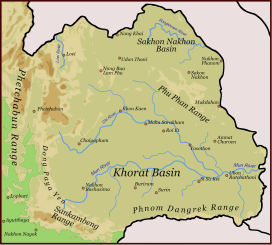Sankamphaeng Range
| Sankamphaeng Range | |
|---|---|
| ทิวเขาสันกำแพง | |
 View of the forested mountains of the Sankamphaeng Range in the Khao Yai National Park area | |
| Highest point | |
| Peak | Khao Rom |
| Elevation | 1,351 m (4,432 ft) |
| Dimensions | |
| Length | 180 km (110 mi) E/W |
| Width | 40 km (25 mi) N/S |
| Geography | |
| Country | Thailand |
| Provinces | Nakhon Ratchasima |
| Range coordinates | 14°26.5′N 101°23′E / 14.4417°N 101.383°E |
| Borders on | Dong Phaya Yen Mountains and Dângrêk Mountains |
| Geology | |
| Type of rock | Sandstone and conglomerate |
The Sankamphaeng Range, also Sankambeng Range or Sungumpang Range (
Description
The meaning of the word Sankamphaeng in the Thai language is fortification or counterfort. It is a fitting name to describe this mountain range that effectively constituted a natural buttress between the Khorat Plateau and the plain of Central Thailand.
The mountain chain runs in a WNW-ESE direction. The northern part of the Sankamphaeng mountain range merges with the southern end of the Dong Phaya Yen Mountains, which run roughly in a north-south direction at the southwestern boundary of the Khorat Plateau.
To the east this range connects with the
The range is divided in two compact massifs where the highest elevations are in the west. The highest point in the Sankamphaeng Range is the 1,351 m high
The eastern massif begins at 992 m high Khao Lamang, 949 m high Phu Sam Ngam, and 843 m high Khao Tap Tao. At this point a branch of the massif extends northeastwards with 748 m high Khao Chawae and 723 m high Khao Plai Lam Katuk, connecting with the southern end of the Dong Phaya Yen Range. Further east there are two mountains with the name "Khao Yai", a 776 m high Khao Yai located north of 761 m high Khao Thuang and a 796 m high Khao Yai located to the south. Further eastwards the average height of the peaks descends to around 400 m and Hwy 348 crosses in this lower area from north to south where the range connects with the Dângrêk Mountains.[2]
Several rivers originate in the Sankamphaeng mountains, of which the Mun River flowing eastwards is the largest. Another important river is the Klong Praprong.[3]
Administratively, most of the area of the range is under
There are
History
Around 1922 a group of people from Ban Tha Dan and Ban Tha Chai villages in
Owing to its location and distance from the authorities, the new subdistrict soon became a refuge for criminals and fugitives. After an attempt by government forces to capture the outlaws in the area, the villagers were relocated onto the plains some 30 km away. In 1932 the tambon status of Khao Yai Subdistrict was cancelled.
In 1959, then Prime Minister of Thailand, Marshall Sarit Thanarat, coordinated the Ministry of Agriculture and the Ministry of the Interior in order to initiate a process where areas of the country could be officially set aside as national parks.
During the
In 1982 a road was built that made it easy for Bangkok residents to reach the main protected area of the mountains.[6]
Ecology
The
Among the
This range, together with the
Protected areas
- Khao Yai National Park, covering an area of 2,165.5 km2, is the largest national park in the Sankamphaeng mountains and one of the most famous in Thailand.
- Phra Phutthachai National Park
- Pang Sida National Park[12]
- Thap Lan National Park[13]
- Ta Phraya District.
- Dong Yai Wildlife Sanctuary
See also
References
- ^ "Bulletin - United States National Museum"
- ^ Map of Bangkok and 22 nearby provinces, PN Map
- ^ Nuntana Pontawepitanun, Sugarcane Industry Zoning in Eastern Thailand[dead link]
- ^ Government Gazette (Book 79, Section 89)
- ^ Khao Khieo RTAB (Green Hill), Thailand Archived 2015-02-27 at the Wayback Machine
- ^ หนังสือคู่มือชุดท่องอุทยาน: อุทยานแห่งชาติเขาใหญ่. สำนักพิมพ์สารคดี, 2543 (Thai)
- ^ "The Nation - Encroachment at Khao Yai National Park". Archived from the original on 2014-07-14. Retrieved 2012-02-08.
- ^ 2 Large Resorts In Taplan National Park Bulldozed In The Night Archived January 11, 2012, at the Wayback Machine
- ^ Conservation of Protected Areas in Thailand: The case of Khao Yai National Park
- ^ Phayung fight crosses border
- ^ Dong Phayayen - Khao Yai Forest Complex
- ^ Pang Sida National Park Archived 2010-01-13 at the Wayback Machine
- ^ Thap Lan National Park
- ^ Ta Phraya National Park

